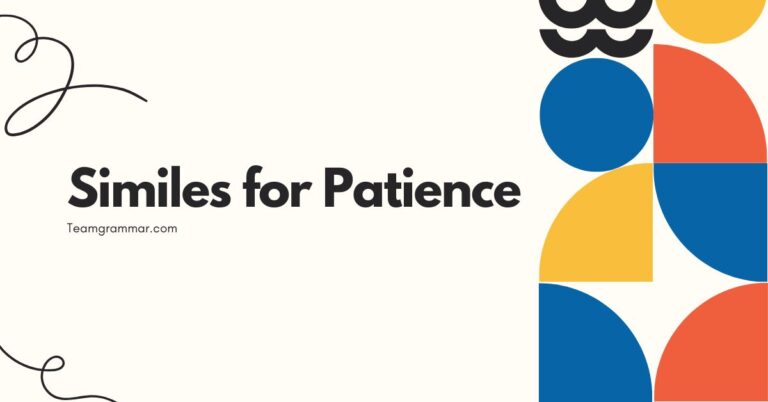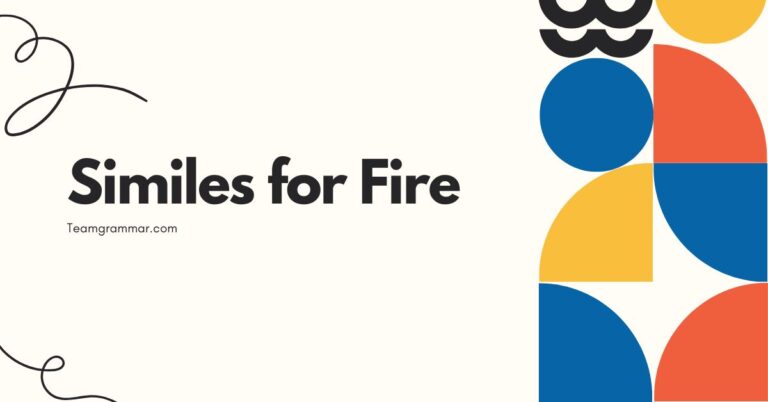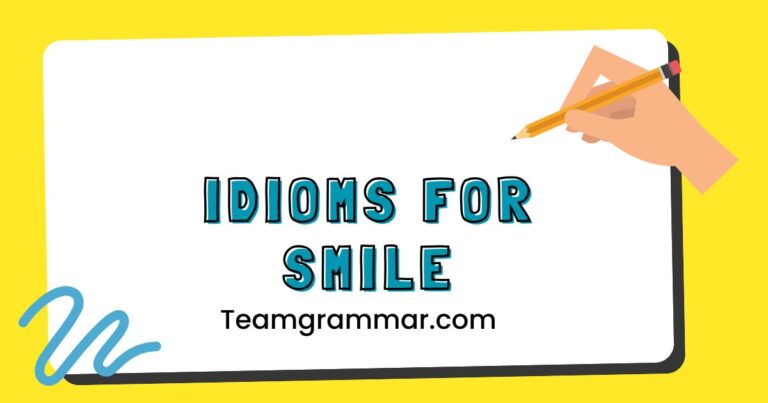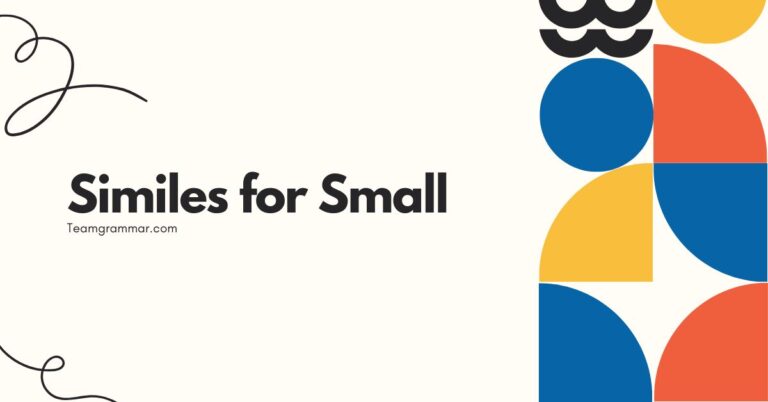45 Similes for Hope: A Comprehensive Grammar Guide
Hope, an abstract concept representing optimism and anticipation, is often best conveyed through vivid language. Similes, comparisons using “like” or “as,” offer a powerful tool to illuminate the multifaceted nature of hope.
Understanding how to craft and interpret similes for hope enriches both writing and comprehension skills. This guide explores the structure, usage, and impact of similes, providing learners with the knowledge to express the nuances of hope effectively.
This article benefits students, writers, and anyone seeking to enhance their expressive capabilities in English.
Table of Contents
- Introduction
- Definition of Similes
- Structural Breakdown of Similes
- Types of Similes for Hope
- Examples of Similes for Hope
- Usage Rules for Similes
- Common Mistakes with Similes
- Practice Exercises
- Advanced Topics in Similes
- Frequently Asked Questions
- Conclusion
Introduction
Similes are essential tools in the English language for creating vivid imagery and conveying complex emotions. When used to describe hope, they can transform an abstract concept into something tangible and relatable.
This article delves into the intricacies of similes for hope, offering a comprehensive guide to understanding their structure, usage, and impact.
By mastering the art of crafting and interpreting similes, you can enhance your writing, communication, and analytical skills. Whether you are a student aiming to improve your essay writing or a professional seeking to refine your communication style, this guide provides valuable insights.
Through numerous examples, exercises, and explanations, this article aims to equip you with the knowledge and confidence to use similes for hope effectively.
Definition of Similes
What is a Simile?
A simile is a figure of speech that compares two unlike things using the words “like” or “as.” The purpose of a simile is to create a vivid image or to emphasize a particular quality of one thing by associating it with something else. In essence, it draws a parallel between two different concepts to highlight a shared characteristic.
Similes are distinct from metaphors, which directly equate two things without using “like” or “as.” While both similes and metaphors are used to create figurative language, similes offer a more explicit comparison. This clarity makes similes particularly useful for conveying complex ideas in a simple and accessible manner.
Function of Similes
The primary function of a simile is to enhance understanding and create a more engaging experience for the reader or listener. By comparing an unfamiliar concept to something familiar, similes can clarify meaning and make abstract ideas more concrete.
This is particularly useful when describing emotions or intangible qualities like hope.
Similes also add depth and color to writing, making it more evocative and memorable. A well-crafted simile can transform a mundane description into a powerful and impactful statement.
In the context of hope, similes can evoke feelings of optimism, resilience, and anticipation.
Similes in Context
Similes are versatile and can be used in various contexts, including literature, poetry, everyday conversation, and persuasive writing. In literature, similes often serve to deepen character development, enhance setting descriptions, and create thematic resonance.
In poetry, similes contribute to the overall aesthetic appeal and emotional impact of the work.
In everyday conversation, similes can add humor, emphasis, or clarity to communication. In persuasive writing, similes can be used to make an argument more compelling or to connect with the audience on an emotional level.
Regardless of the context, the effective use of similes requires careful consideration of the relationship between the two things being compared.
Structural Breakdown of Similes
Components of a Simile
A simile typically consists of three main components: the subject, the linking word (“like” or “as”), and the object of comparison. The subject is the thing being described, while the object of comparison is the thing it is being compared to.
The linking word establishes the connection between the two.
For example, in the simile “Hope is like a lighthouse,” “hope” is the subject, “like” is the linking word, and “a lighthouse” is the object of comparison. The simile suggests that hope, like a lighthouse, provides guidance and direction in times of darkness or uncertainty.
Patterns and Variations
While the basic structure of a simile is straightforward, there are variations in how it can be expressed. Similes can be expanded to include more descriptive details or to emphasize specific aspects of the comparison.
They can also be embedded within longer sentences or used in conjunction with other figures of speech.
One common variation is the use of “as…as” to compare two things in terms of a particular quality. For example, “Hope is as bright as the morning sun” emphasizes the intensity and radiance of hope.
Another variation involves using more complex or metaphorical objects of comparison to create a deeper, more nuanced meaning.
Creating Effective Similes
To create effective similes, it is important to choose objects of comparison that are both relevant and evocative. The comparison should be clear and understandable, and it should add something meaningful to the description.
Avoid clichés or overused similes, as they can detract from the originality and impact of your writing.
Consider the connotations and associations of the object of comparison. Does it evoke positive or negative feelings?
Does it align with the overall tone and message of your writing? By carefully selecting your objects of comparison, you can create similes that are both powerful and effective.
Types of Similes for Hope
Similes Using Light
Light is a common metaphor for hope, and similes that incorporate light can be particularly effective. These similes often evoke feelings of clarity, guidance, and optimism.
Examples include “Hope is like a beacon in the darkness” and “Hope is as radiant as the morning sun.”
These similes draw on the universal association of light with positivity and guidance. They suggest that hope can illuminate a path forward, even in the most challenging circumstances.
The intensity and color of the light can also be varied to convey different shades of hope.
Similes Using Nature
Nature provides a rich source of imagery for similes about hope. Similes that reference natural elements like flowers, trees, and rivers can evoke feelings of growth, resilience, and renewal.
Examples include “Hope is like a seed that grows into a tree” and “Hope is as persistent as a river flowing to the sea.”
These similes draw on the inherent beauty and vitality of the natural world. They suggest that hope, like nature, is capable of overcoming obstacles and enduring through difficult times.
The specific natural element chosen can also convey different aspects of hope, such as the delicate beauty of a flower or the unwavering strength of a tree.
Similes Using Abstract Concepts
Similes can also compare hope to other abstract concepts, such as faith, love, or peace. These similes often explore the interconnectedness of these emotions and their role in sustaining hope.
Examples include “Hope is like a bridge to faith” and “Hope is as essential as love.”
These similes delve into the deeper philosophical and emotional dimensions of hope. They suggest that hope is not an isolated emotion but is intertwined with other positive feelings and beliefs.
By connecting hope to these broader concepts, similes can create a more profound and meaningful understanding of its significance.
Examples of Similes for Hope
Light Similes Examples
The following table provides examples of similes that use light to describe hope, showcasing the variety of ways this comparison can be expressed.
| Simile | Explanation |
|---|---|
| Hope is like a flickering candle in the darkness. | Suggests hope is fragile but still present. |
| Hope is as bright as the morning sun. | Emphasizes the radiance and optimism of hope. |
| Hope is like a guiding star in the night sky. | Implies hope provides direction and guidance. |
| Hope is as warm as a ray of sunshine. | Conveys the comforting and nurturing aspect of hope. |
| Hope is like a lighthouse in a storm. | Indicates hope offers safety and security. |
| Hope is as clear as a sunlit stream. | Suggests clarity and purity of hope. |
| Hope is like a spark that ignites a flame. | Implies potential and growth. |
| Hope is as steady as a burning ember. | Conveys endurance and resilience. |
| Hope is like a beacon calling sailors home. | Suggests a return to safety and comfort. |
| Hope is as illuminating as a flash of lightning. | Implies sudden understanding or clarity. |
| Hope is like the first light after a long night. | Suggests relief and a new beginning. |
| Hope is as golden as the setting sun. | Conveys warmth and beauty. |
| Hope is like the glimmer of a distant star. | Implies a far-off but reachable goal. |
| Hope is as radiant as a diamond. | Suggests preciousness and brilliance. |
| Hope is like a lantern in the fog. | Indicates guidance in uncertain times. |
| Hope is as comforting as candlelight. | Conveys a sense of peace and tranquility. |
| Hope is like a sunbeam breaking through clouds. | Suggests overcoming obstacles. |
| Hope is as vibrant as a neon sign. | Implies energy and excitement. |
| Hope is like a flashlight in a dark room. | Indicates guidance and clarity. |
| Hope is as pure as the light of dawn. | Suggests a fresh start and new possibilities. |
| Hope is like a streetlamp on a lonely road. | Conveys guidance and companionship. |
| Hope is as warm as the glow of a fireplace. | Suggests comfort and security. |
| Hope is like a firefly in the summer night. | Implies small but persistent light. |
| Hope is as constant as the sun’s daily return. | Conveys reliability and predictability. |
Nature Similes Examples
The following table provides examples of similes that use elements of nature to describe hope, emphasizing growth, resilience, and renewal.
| Simile | Explanation |
|---|---|
| Hope is like a seed planted in fertile ground. | Suggests potential for growth and prosperity. |
| Hope is as resilient as a wildflower pushing through concrete. | Emphasizes strength and perseverance. |
| Hope is like a river flowing towards the sea. | Implies unwavering determination and progress. |
| Hope is as refreshing as a gentle rain after a drought. | Conveys relief and rejuvenation. |
| Hope is like a tree that bends but does not break in the wind. | Indicates flexibility and adaptability. |
| Hope is as enduring as the mountains. | Suggests permanence and strength. |
| Hope is like a sunrise after a stormy night. | Implies a new beginning and brighter days. |
| Hope is as abundant as the stars in the night sky. | Conveys limitless possibilities. |
| Hope is like a blooming flower in spring. | Suggests beauty and renewal. |
| Hope is as constant as the tides. | Implies reliability and predictability. |
| Hope is like a sturdy oak tree weathering a storm. | Suggests strength and resilience. |
| Hope is as vibrant as a lush green forest. | Conveys vitality and abundance. |
| Hope is like a bird soaring freely in the sky. | Implies freedom and liberation. |
| Hope is as deep as the ocean. | Suggests endless possibilities and potential. |
| Hope is like a warm breeze on a summer day. | Conveys comfort and relaxation. |
| Hope is as nurturing as the earth. | Implies care and support. |
| Hope is like a sunflower turning towards the sun. | Suggests optimism and positivity. |
| Hope is as persistent as ivy climbing a wall. | Conveys determination and perseverance. |
| Hope is like a rainbow after the rain. | Indicates promise and beauty after hardship. |
| Hope is as fertile as a well-nourished field. | Suggests potential for growth and abundance. |
| Hope is like a babbling brook finding its way. | Implies persistence and direction. |
| Hope is as refreshing as a mountain spring. | Conveys renewal and purity. |
| Hope is like a quiet forest, full of potential. | Suggests untapped resources and serenity. |
| Hope is as gentle as a falling leaf. | Conveys peace and acceptance. |
Abstract Similes Examples
The following table provides examples of similes that use abstract concepts to describe hope, exploring its relationship with faith, love, and other positive emotions.
| Simile | Explanation |
|---|---|
| Hope is like a bridge connecting dreams to reality. | Suggests hope facilitates the realization of aspirations. |
| Hope is as essential as love. | Emphasizes the fundamental importance of hope. |
| Hope is like a compass guiding us towards our goals. | Implies direction and purpose. |
| Hope is as comforting as faith. | Conveys reassurance and solace. |
| Hope is like a shield protecting us from despair. | Indicates protection and resilience. |
| Hope is as powerful as belief. | Suggests strength and conviction. |
| Hope is like a song that lifts our spirits. | Implies joy and inspiration. |
| Hope is as vital as courage. | Emphasizes the importance of bravery. |
| Hope is like a promise of a better tomorrow. | Suggests future possibilities and improvements. |
| Hope is as unwavering as loyalty. | Implies steadfastness and dedication. |
| Hope is like a gentle hand guiding us forward. | Suggests support and direction. |
| Hope is as precious as peace. | Conveys value and tranquility. |
| Hope is like a lifeline in times of trouble. | Implies rescue and support. |
| Hope is as necessary as trust. | Suggests reliance and faith. |
| Hope is like a dream that keeps us going. | Indicates motivation and inspiration. |
| Hope is as strong as determination. | Emphasizes resolve and persistence. |
| Hope is like a silent prayer for better days. | Suggests faith and supplication. |
| Hope is as boundless as imagination. | Conveys limitless possibilities. |
| Hope is like a quiet strength that sustains us. | Implies inner resilience and support. |
| Hope is as refreshing as forgiveness. | Suggests renewal and release. |
| Hope is like a melody that soothes the soul. | Conveys comfort and peace. |
| Hope is as comforting as acceptance. | Implies understanding and support. |
| Hope is like a silent understanding between friends. | Suggests connection and empathy. |
| Hope is as reliable as integrity. | Conveys trustworthiness and honesty. |
Usage Rules for Similes
Clarity and Relevance
A good simile should be clear and easy to understand. The comparison should be relevant to the subject being described and should enhance the reader’s understanding.
Avoid using obscure or convoluted comparisons that may confuse the audience.
Ensure that the object of comparison shares a meaningful characteristic with the subject. The connection should be logical and should add depth to the description.
A random or arbitrary comparison will not be effective and may even detract from the overall impact of your writing.
Originality and Avoiding Cliches
Strive for originality in your similes. While some common similes can be effective, overused clichés can make your writing sound uninspired and predictable.
Take the time to craft unique and imaginative comparisons that will surprise and delight your readers.
Instead of saying “Hope is like a light at the end of the tunnel,” which is a common cliché, try something more original, such as “Hope is like a hidden spring in the desert,” which evokes a more vivid and unexpected image.
Consistency and Tone
Ensure that your similes are consistent with the overall tone and style of your writing. A simile that is too humorous or informal may be out of place in a serious or academic context.
Consider the audience and purpose of your writing when selecting your similes.
Maintain a consistent level of formality and sophistication throughout your writing. Avoid mixing overly simplistic similes with complex or technical language.
The goal is to create a cohesive and harmonious effect that enhances the overall impact of your message.
Common Mistakes with Similes
Confusing Similes and Metaphors
A common mistake is confusing similes with metaphors. Remember that similes use “like” or “as” to make a comparison, while metaphors directly equate two things without using these words.
For example, “Hope is like a beacon” is a simile, while “Hope is a beacon” is a metaphor.
Understanding the distinction between similes and metaphors is crucial for using them correctly and effectively. Using a simile when a metaphor is more appropriate, or vice versa, can weaken the impact of your writing and create confusion for the reader.
Using Weak or Irrelevant Comparisons
Another common mistake is using weak or irrelevant comparisons. A simile should add something meaningful to the description and should help the reader understand the subject more clearly.
If the comparison is vague or unrelated, it will not be effective.
For example, saying “Hope is like a thing” is a weak and meaningless comparison. A more effective simile would be “Hope is like a lifeline,” which conveys a specific and relevant image of support and rescue.
Overusing Similes
While similes can be a powerful tool, overusing them can make your writing sound forced and unnatural. Use similes sparingly and only when they truly enhance the description.
Too many similes can clutter your writing and distract from your message.
Aim for a balance between figurative language and direct, straightforward language. Use similes to add color and depth to your writing, but avoid relying on them too heavily.
The most effective writing often combines both types of language to create a rich and engaging experience for the reader.
Practice Exercises
Exercise 1: Identifying Similes
Identify the similes in the following sentences. Underline the simile and identify the two things being compared.
| Question | Answer |
|---|---|
| 1. Her hope was like a fragile butterfly, easily crushed. | Her hope was like a fragile butterfly. Hope and a butterfly. |
| 2. The child’s eyes were as bright as stars. | The child’s eyes were as bright as stars. Eyes and stars. |
| 3. Hope is a powerful force. | No simile present. |
| 4. His spirit was as strong as an oak. | His spirit was as strong as an oak. Spirit and an oak. |
| 5. The idea sparked hope like a match. | The idea sparked hope like a match. Idea and match. |
| 6. Hope is the thing with feathers. | No simile present. |
| 7. The new job felt like a fresh start. | The new job felt like a fresh start. New job and fresh start. |
| 8. She clung to hope as a drowning person clings to a raft. | She clung to hope as a drowning person clings to a raft. Hope and a raft. |
| 9. The future seemed as uncertain as a stormy sea. | The future seemed as uncertain as a stormy sea. Future and stormy sea. |
| 10. Hope is an anchor in the storm. | No simile present. |
Exercise 2: Completing Similes
Complete the following similes by adding an appropriate object of comparison.
| Question | Answer |
|---|---|
| 1. Hope is like __________. | Hope is like a sunrise. |
| 2. Hope is as bright as __________. | Hope is as bright as the morning star. |
| 3. Hope is like a _________ in the darkness. | Hope is like a candle in the darkness. |
| 4. Hope is as strong as __________. | Hope is as strong as a mountain. |
| 5. Hope is like a _________ in the desert. | Hope is like an oasis in the desert. |
| 6. Hope is as reliable as __________. | Hope is as reliable as the tides. |
| 7. Hope is like a _________ after the rain. | Hope is like a rainbow after the rain. |
| 8. Hope is as refreshing as __________. | Hope is as refreshing as a cool breeze. |
| 9. Hope is like a _________ guiding us forward. | Hope is like a compass guiding us forward. |
| 10. Hope is as warm as __________. | Hope is as warm as a summer day. |
Exercise 3: Creating Similes
Create your own similes to describe hope, using the words “like” or “as.”
| Prompt | Example Answer |
|---|---|
| 1. Describe hope using the word “like.” | Hope is like a gentle hand guiding you through the dark. |
| 2. Describe hope using the word “as.” | Hope is as resilient as a plant pushing through concrete. |
| 3. Create a simile for hope using a metaphor related to light. | Hope is like a small ember that can ignite a great fire. |
| 4. Create a simile for hope using a metaphor related to nature. | Hope is as persistent as a river flowing to the sea. |
| 5. Create a simile for hope using an abstract concept. | Hope is like a bridge connecting dreams to reality. |
| 6. Describe hope using the word “like” and relating it to music. | Hope is like a soothing melody that calms the soul. |
| 7. Describe hope using the word “as” and relating it to weather. | Hope is as refreshing as the first rain after a long drought. |
| 8. Create a simile for hope using a metaphor related to travel. | Hope is like a compass guiding us on our journey. |
| 9. Create a simile for hope using a metaphor related to family. | Hope is like a loving embrace that provides comfort and security. |
| 10. Create a simile for hope using a metaphor related to art. | Hope is like a blank canvas, full of endless possibilities. |
Advanced Topics in Similes
Extended Similes
An extended simile is a simile that is developed over several lines or sentences, providing a more detailed and elaborate comparison. This technique allows for a deeper exploration of the relationship between the two things being compared and can create a more powerful and lasting impression on the reader.
For example, instead of simply saying “Hope is like a lighthouse,” an extended simile might read: “Hope is like a lighthouse, standing tall and unwavering against the crashing waves of despair. Its beam cuts through the darkness, guiding lost ships safely to shore, offering a beacon of safety and reassurance in the midst of the storm.”
Subverted Similes
A subverted simile is a simile that intentionally violates the reader’s expectations, creating a surprising or ironic effect. This technique can be used to challenge conventional thinking, to create humor, or to add a layer of complexity to the writing.
For example, instead of saying “Hope is like a warm blanket,” a subverted simile might read: “Hope is like a warm blanket, but one that is perpetually just out of reach,” which suggests a more cynical or disillusioned view of hope.
Similes in Poetry
Similes are a common and effective tool in poetry, where they can be used to create vivid imagery, to convey complex emotions, and to enhance the overall aesthetic appeal of the poem. Poets often use similes to draw connections between the abstract and the concrete, to explore the nuances of human experience, and to create a sense of wonder and awe.
The effectiveness of similes in poetry depends on the poet’s ability to choose objects of comparison that are both evocative and meaningful. The best similes are those that resonate with the reader on an emotional level and that contribute to the overall thematic unity of the poem.
Frequently Asked Questions
-
What is the difference between a simile and a metaphor?
A simile is a comparison using “like” or “as,” while a metaphor directly equates two things without using these words. For example, “Hope is like a light” (simile) versus “Hope is a light” (metaphor). Similes are more explicit comparisons, while metaphors are more implicit and often more powerful.
-
How can I make my similes more original?
Avoid clichés and overused comparisons. Think outside the box and choose objects of comparison that are unexpected but still relevant and meaningful. Consider the specific qualities you want to emphasize and look for comparisons that capture those qualities in a unique way. Brainstorm different ideas and experiment with different combinations until you find something that feels fresh and original.
-
Is it okay to use similes in formal writing?
Yes, similes can be used in formal writing, but they should be used sparingly and with careful consideration of the audience and purpose. Avoid overly informal or humorous similes in serious or academic contexts. Choose comparisons that are sophisticated and that enhance the clarity and impact of your message.
-
How can I avoid overusing similes in my writing?
Use similes only when they truly enhance the description and add something meaningful to your writing. Vary your sentence structure and use a mix of figurative and literal language. If you find that you are relying too heavily on similes, try to rephrase some of your sentences using more direct and straightforward language.
-
What are some common mistakes to avoid when using similes?
Common mistakes include confusing similes with metaphors, using weak or irrelevant comparisons, overusing similes, and using clichés. Always double-check your similes to ensure that they are clear, relevant, original, and consistent with the overall tone and style of your writing.
-
Can a simile be too complex?
Yes, a simile can be too complex if it is difficult to understand or if it distracts from the main point of your writing. The goal of a simile is to enhance understanding, not to confuse the reader. Choose comparisons that are clear and accessible, and avoid using overly technical or obscure language.
-
How do I choose the right object to compare hope to in a simile?
Consider what aspects of hope you want to emphasize. Do you want to highlight its resilience, its brightness, its guiding nature, or something else? Choose an object that embodies those qualities. For example, if you want to emphasize the guiding nature of hope, you might compare it to a lighthouse or a compass.
-
What role do similes play in conveying emotion?
Similes can evoke emotions by associating the subject with something that already carries emotional weight. For instance, comparing hope to a warm fire evokes feelings of comfort and security, while comparing it to a fragile butterfly evokes feelings of tenderness and vulnerability. The key is to choose objects that resonate emotionally with your audience.
-
Are there cultural considerations when using similes?
Yes, cultural context can influence the effectiveness of a simile. Objects and concepts may have different connotations in different cultures. A simile that resonates strongly in one culture might not have the same impact in another. Be mindful of your audience and choose comparisons that are likely to be understood and appreciated by them.
-
How can I practice writing better similes?
Practice regularly by creating similes for different subjects and emotions. Read widely and pay attention to how other writers use similes effectively. Ask for feedback from others and be open to constructive criticism. The more you practice, the better you will become at crafting similes that are both creative and effective.
Conclusion
Mastering the art of using similes for hope involves understanding their structure, function, and appropriate usage. By choosing clear, original, and relevant comparisons, writers can effectively convey the multifaceted nature of hope and create a lasting impact on their audience.
Avoiding common mistakes and practicing regularly will further enhance one’s ability to craft powerful and evocative similes.
Similes serve as a vital tool in enhancing communication, adding depth, and creating vivid imagery. By understanding the nuances and avoiding common pitfalls, one can effectively use similes to express the profound essence of hope.
Continued practice and awareness of the emotional and cultural contexts will allow you to create resonant and impactful similes.
The key takeaways from this guide include the importance of clarity, originality, and consistency in crafting similes. By applying these principles and engaging in regular practice, you can elevate your writing and effectively communicate the power and beauty of hope.
Remember to consider the audience and purpose of your writing when selecting your comparisons, and always strive for a balance between figurative and literal language.







